USS CABOT (CVL-28)
(later AVT-3)




|
|
||||||





|
||||||


| ||||||
Class: INDEPENDENCE
As built: Displacement: 11,000 tons (15,100 fl) — Dimensions: 600' wl (622' 6" oa) x 71' 6" (109' 2" fd) x 26' (max) / 182.9 wl (189.7 oa) x 21.8 (33.3 fd) x 7.9 (max) meters — Armor: 1.5"-5" belt, 3" main deck, 0.38" bridge — Power plant: 4 565-psi boilers, 4 geared turbines, 4 screws; 100,000 shp — Speed: 31.6 knots — Endurance (design): 12,500 nm @ 15 knots — Armament: 26 40-mm (2x4, 9x2); 16 20-mm — Aircraft: 30+ — Aviation facilities: 2 elevators; 1 hydraulic catapult — Crew: approx. 1,560
Ordered as the Cleveland-class light cruiser Wilmington (CL-79). Contract awarded to New York Shipbuilding Corp., Camden, N.J. Laid down 16 Mar 1942. Reordered as carrier and redesignated CV-28, 2 Jun 1942; renamed Cabot 23 Jun 1942. Launched 4 Apr 1943. Redesignated as "Light Aircraft Carrier" (CVL-28) 15 Jul 1943. Commissioned 24 Jul 1943. She was awarded a Presidential Unit Citation and nine "Battle Stars" for service during WW II; damaged by kamikaze 25 Nov 1944. Decommissioned to reserve 11 Feb 1947.
Recommissioned 27 Oct 1948 as a Naval Air Reserve training carrier. Modernized for ASW support in Mar 1950-Feb 1951. Decommissioned to reserve 21 Jan 1955. Reclassified as an "Aircraft Transport" and redesignated AVT-3, 15 May 1959, while in reserve.
Overhauled at Philadelphia Naval Shipyard (1965-67) in preparation for transfer to Spain. Loaned to Spain, renamed Dédalo and commissioned 30 Aug 1967; she was used as an ASW helicopter carrier and designated PH-01. Stricken from US NVR 1 Aug 1972; sold to Spain 5 Dec 1972. Reclassified as an aircraft carrier and redesignated PA-01, 28 Sep 1976, shortly before she began operating Harriers. Redesignated R-01, in accordance to NATO practice, in 1980.
FATE:
Stricken from the Spanish Navy List, 5 Aug 1989, at New Orleans, and donated to a private organization for preservation as a museum ship. Plans to memorialize her, however, met with no success in subsequent years (see Hazegray & Underway); she was sold for scrapping in 1997 and towed to Port Isabel, TX (18 Oct), then to Brownsville (9 Aug 1998). Further efforts to preserve the last of the World War II CVLs failed, too, and stripping work began in Oct 2000; as of mid-2002, scrapping was nearing completion (visit USS Cabot Museum for more information and photos).| Click On Image
For Full Size Image |
Size | Image Description | Contributed
By And/Or Copyright |
||||||
|---|---|---|---|---|---|---|---|---|---|
| Name |
|||||||||
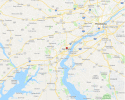 NS022826a |
161k | Ordered 9 September 1940 as a Cleveland-class light cruiser, this ship was assigned hull number CL-79 and named Wilmington, for a city in Delaware (NS022826a). Designated for completion as an aircraft carrier, she was redesignated CV-28 on 2 June 1942, and renamed Cabot on 23 June 1942. The first Cabot, a Continental Navy brig (1775–1777), was named after Giovanni Caboto (1450?-1499?), a Venetian navigator better known to the English-speaking world by the anglicized form of his name, John Cabot. Although most details of Cabot's life and voyages are a subject of debate among historians, it is certain that he was the first European (after the Vikings) to reach the North American continent, 24 June 1497, while sailing under the sponsorship of King Henry VII of England. On the ground that Cabot had been the first explorer to reach the mainland, England later claimed all of North America. (The name Cabot was temporarily assigned to CV-16.) The second Cabot, CVL-28, was named for the old "famous ship of that name." (Very special thanks to Robert J. Cressman, Naval History & Heritage Command.) (Map NS022826a courtesy of Hamstermap.com.) NS022826: The Continental Fleet at sea. Left to right are the brig Cabot, brig Andrew Doria, ship Alfred, sloop Hornet, schooner Fly, ship Columbus, sloop Providence, and schooner Wasp. Modern painting by W. Nowland Van Powell, from The American Navies of the Revolutionary War, 1974. |
NavSource | ||||||
 NS022826 |
138k | ||||||||
| In U.S. Service |
|||||||||
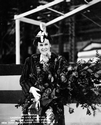 NS022877 |
600k | Mrs. Albert C. Read (Elizabeth "Bess" Burdine Read), ship's sponsor of USS Cabot (CV-28), before launching at New York Shipbuilding Corporation, Camden, New Jersey. Photograph released 4 April 1943. National Archives and Records Administration (NARA) photo, # 80-G-41536. |
NARA | ||||||
 NS022877a |
757k | Mrs. Albert C. Read (Elizabeth "Bess" Burdine Read), ship's sponsor of USS Cabot (CV-28), christening the ship at New York Shipbuilding Corporation, Camden, New Jersey. Photograph released 4 April 1943. National Archives and Records Administration (NARA) photo, # 80-G-41539. |
NARA | ||||||
 NS022877b |
924k | The future USS Cabot (CV-28), launching at Camden, New Jersey. Photographed on Sunday, 4 April 1943. National Archives and Records Administration (NARA) photo, # 80-G-41832. |
NARA | ||||||
 NS022808 |
36k | Postcard. Date unknown | Joe Radigan | ||||||
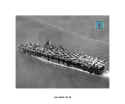 NS022892 |
26k | USS Cabot (CVL-28) underway, date and location unknown. | Tommy Trampp | ||||||
 NS022814 |
73k | USS Cabot (CVL-28) off the Philadelphia Navy Yard, Pennsylvania, on 27
August 1943.
Bureau of Ships Photograph, from the Collections of the Naval Historical Center (photo # NH 45507). |
NHC | ||||||
NS022807 |
47k | This picture was taken on 29 October 1943, off Philadelphia Navy Yard, with the usual radar equipment, but with an incomplete flight deck identification number. Cabot evidently carried Measure 14 camouflage on commissioning, and, like Langley (CVL-27) and Lexington (CV-16) was never given a multi-color camouflage design. (Thanks to Robert Hurst, who provided this information). |
Joe Radigan | ||||||
 NS022811 |
106k | Closeup view of the ship's port side bridge wing, showing her insignia, circa 1943-44. The design is based on the slogan of Cabot's first Commanding Officer, Captain Malcolm F. Schoeffel: "Up Mohawks, At 'Em!". "Mohawk" was the ship's voice radio call sign at the time. (See also NS022848). Official U.S. Navy Photograph, now in the collections of the National Archives (photo # 80-G-263253). |
Scott Dyben | ||||||
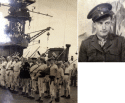 NS022873 |
92k | US Marine Detachment aboard USS Cabot (CVL-28), crossing the Equator, January 1944. Platoon Sergeant Francis J. Hayde, USMC, 1943–1945, is in the photo, in the dark blue tunic, wiping something from his eye. |
Donald F. Hayde, for his father, PLSGT Francis J. Hayde, USMC Via Bob Canchola, BT, USS Oriskany 1971–73 |
||||||
 NS022875 |
80k | Marine Detachment aboard USS Cabot (CVL-28) exercising 20-mm gun, port side amidships. Date and location unknown. |
Donald F. Hayde, for his father, PLSGT Francis J. Hayde, USMC Via Bob Canchola, BT, USS Oriskany 1971–73 |
||||||
 NS022889 |
673k | Burial at sea, 30 April 1944. AMM2/c Wallace James Schuetz, Torpedo Squadron (VT) 8, Carrier Air Group (CAG) 8, USS Bunker Hill (CV-17) was killed in action the previous day, while attacking Truk, when his aircraft (TBF-1C Avenger BuNo 47922, #27), was hit by Japanese AAA. Since the flight deck of his own carrier was fouled, and believing his gunner was seriously wounded but still alive, pilot, ENS (LT(JG)?) L.G. Mason, recovered aboard USS Cabot (CVL-28). Sadly, 22-year-old Schuetz was already dead. He was buried at sea with full military honors at 1116, 30 April. |
Bob Canchola, BT, USN (Ret.) | ||||||
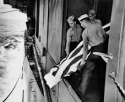 NS022889a |
652k | ||||||||
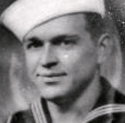 NS022889b |
36k | ||||||||
 NS022891 |
675k | Japanese carrier Chiyoda is hit aft and near-missed several times during air attacks by Task Force (TF) 58 planes, 20 June 1944. Photographed by USS Cabot (CVL-28). NS022891: Official U.S. Navy Photograph, now in the collections of the National Archives and Records Administration (NARA), #80-G-263175. NS022891a: Official U.S. Navy Photograph, now in the collections of the National Archives and Records Administration (NARA), #80-G-263175. |
NARA | ||||||
 NS022891a |
864k | ||||||||
 NS022882 |
48k | Last photo of Figthing Squadron (VF) 31 "Flying Meataxers" aboard USS Cabot (CVL-28). With 165.6 victories, VF-31 was the highest-scoring CVL (light carrier) squadron, and the 7th Navy squadron. With half the planes and pilots, it equalled or even outscored some VF squadrons aboard Essex-class carriers. They had the highest kill ratio per pilot of any squadron in the U.S. Navy, a record that stands today. Cabot carried Air Group 31 from the time of her shakedown cruise until they were rotated out of active duty in October of 1944. Air Group 31 was replaced by Air Group 29, that served aboard Cabot until 11 July 1945. AG31 was in turn relieved by Air Group 32, that served for the last six weeks until the end of hostilities. VF-31's second cruise, aboard USS Belleau Wood (CVL-24) in July 1945, produced only three days of air combat, but added 19 kills to their score. (Partial text from U.S. Navy Fighter Squadrons in World War II, by Barrett Tillman.) |
Bill Gonyo | ||||||
 NS022882a |
480k | LT Adolph J. "Al" Mencin was the Executive Officer (XO) of VF-31. During his tenure aboard USS Cabot (CVL-28) he was awarded the Silver Star twice, the Distinguished Flying Cross, and the Air Medal with three Gold Stars. He was an air combat Ace with six victories over Japanese aircraft. The "Flying Meataxers" destroyed 165.6 Japanese airplanes in aerial combat, top among all CVL (light carrier) squadrons. They deployed with Cabot from November 1943 through September 1944. The squadron was established on 1 May 1943, under command of LCDR Robert A. Winston, and left San Diego NAS in November 1943, to take part in the havoc that the Fast Carrier Task Force wreaked upon the Japanese Navy in 1944. |
|||||||
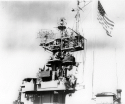 NS022841 |
667k | A view of the island of USS Cabot (CVL-28). USN photo. Judging from Air Group 29's (VF-29 & VT-29) scoreboard this picture was probably taken in October (or perhaps November) 1944. The curved antenna of the surface search SG radar is seen on the raised circular platform. Forward of and below it is the SC-2 air search radar antenna. A second air search radar (SK) was installed on a stub mast between the pairs of uptakes—all fleet carriers were fitted with two air search sets as insurance against the failure of one of them in combat, and the wide separation of both main radars aboard CVLs often resulted in better radar performance than that enjoyed by the heavier and larger CVs. |
David Buell Larger copy submitted by Pieter Bakels |
||||||
 NS022812 |
76k | USS Cabot (CVL-28) is hit by a Kamikaze, while operating with Task Force 38 off Luzon, 25 November 1944. Official U.S. Navy Photograph, now in the collections of the National Archives (photo # 80-G-289608). |
Scott Dyben | ||||||
 NS022812a |
77k | "Destroyed gun tub." |
Donald F. Hayde, for his father, PLSGT Francis J. Hayde, USMC Via Bob Canchola, BT, USS Oriskany 1971–73 |
||||||
 NS022842 |
184k | Memorial service aboard USS Cabot (CVL-28). USN photo via Floating Drydock. In all probability this picture shows the burial at sea, November 26, 1944 of five of the victims of the kamikaze attack the day before. Donald F. Hayde comments: "The group on the left are Marines and the body no doubt is of Sergeant Major Lewis J. Camp, since he was the only Marine KIA [that day]." (For a list of casualties, see "The Kamikaze Attack and Related Stories," Chapter 7 of J. Ed Hudson's A History of the USS Cabot (CVL-28): A Fast Carrier in World War II.) |
David Buell | ||||||
 NS022842a |
70k | "RIP Sgt Maj Lewis J. Camp." |
Donald F. Hayde, for his father, PLSGT Francis J. Hayde, USMC Via Bob Canchola, BT, USS Oriskany 1971–73 |
||||||
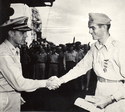 NS022868 |
394k | Captain Stanley J. Michael, commanding officer of USS Cabot (CVL-28), presents the Distinguished Flying Cross to Lieutenant (Junior Grade) Arthur Ray Hawkins, 1944–1945. Hawkins was awarded three Navy Crosses and three Distinguished Flying Crosses while serving with Fighting Squadron (VF) 31 aboard Cabot and USS Belleau Wood (CVL-24), and went on to become one of the original members of the "Blue Angels." |
Bill Gonyo | ||||||
 NS022874 |
61k | Commander William Henry Anderson served in Torpedo Squadron (VT) 29, embarked aboard USS Cabot (CVL-28) between 1944 and 1945. During this period then Lieutenant Anderson was awarded the Navy Cross (October 1944) and two Distinguished Flying Crosses (January–February 1945 and April 1945). Citation (Navy Cross): "The President of the United States takes pleasure in presenting the Navy Cross to William Henry Anderson, Jr. (0-116656), Lieutenant, U.S. Navy (Reserve), for extraordinary heroism in operations against the enemy while serving as Pilot of a carrier-based Navy Torpedo Plane of Torpedo Squadron TWENTY-NINE (VT-29), embarked from the U.S.S. Cabot (CVL-28), in the Philippine Sea on 24 October 1944. Lieutenant Anderson participated in torpedo attacks which severely crippled an enemy Battleship Task Force. The action, in which he was an integral part, successfully accomplished in the face of intense and accurate anti-aircraft barrages, removed a serious threat to our ground forces. His outstanding courage and determination in the face of great danger were in keeping with the highest traditions of the United States Naval Service." Commander, 2d Carrier Task Force, Pacific: Serial 0876 (11 January 1945). |
Bill Gonyo | ||||||
 NS022860 |
88k | Port broadside photo of USS Cabot (CVL-28) during flight operations, circa 1945. An F6F Hellcat fighter is in the process of recovering aboard. |
Mike Green | ||||||
 NS022815 |
96k | USS Cabot (CVL-28) flies a long "Homeward Bound" pennant as she departs
the Western Pacific for overhaul in San Francisco, California, 13 April 1945. She had been
operating in the combat zone since January 1944. View looks aft from the ship's island, with
her SK-1 radar antennna at left and other shipping in the distance. Aircraft on
Cabot's deck include (from right front): OS2U, SOC, TBM, SB2C, F4U and F6F
types.
Official U.S. Navy Photograph, from the collections of the Naval Historical Center (photo # NH 96958). |
NHC | ||||||
 NS022813 |
112k | Underway at sea, 26 July 1945. Official U.S. Navy Photograph, now in the collections of the National Archives (photo # 80-G-262768). Cabot had departed Pearl Harbor on 24 July as part of Task Force 12.3 with battleship Pennsylvania (BB-38), a destroyer screen, and a new Air Group (AG32) aboard. En route to Eniwetok, the carrier launched three strikes on Wake Island on 1 August; Pennsylvania and DD's also used their guns against the Japanese-held island—the main goal of the strikes was to destroy all shore batteries. |
Scott Dyben | ||||||
 NS022843 |
181k | Another view of USS Cabot (CVL-28) at sea. It appears to have been taken shortly after photo NS022813, above. |
David Buell | ||||||
 NS022872 |
147k | USS Cabot (CVL-28), Cuba, 27 April 1946. |
Photos by Ralph K. Lichtenberger RM3/c USS LSM(R)-510, submitted by his son, Ralph Lichtenberger AM3 USN |
||||||
 NS022872a |
153k | ||||||||
NS022801 |
67k | Cabot underway with aircraft on deck in this undated image (possibly taken in the late 1940s; note the SK-2 radar antenna on the mast between her funnels). | USN | ||||||
 NS022859 |
268k | Undated (late 1940s) aerial photo of USS Cabot (CVL-28). US Navy and Marine Corps Museum/Naval Aviation Museum photo. |
Mike Green | ||||||
 NS022840 |
240k | Official US Navy Photograph of USS Cabot (CVL-28,) as a Naval Reserve Training Carrier, berthed at Alleghany Pier Naval Air Station Pensacola, FL in 1949. The photo is from Headquarters Naval Air Training Command, NAS Pensacola. |
Robert M. Cieri | ||||||
 NS022879 |
49k | Photo believed to have been taken aboard USS Cabot (CVL-28) in 1949, in Miami, Florida. |
Tommy Trampp | ||||||
 NS022857 |
780k | USS Cabot (CVL-28) underway. Planes on deck appear to be from Glenview, Illinois, based VF-721 Reserve squadron. USN photo, dated February 1949. |
David Buell | ||||||
 NS022851 |
265k | "Every flight student mades at least six landings aboard USS Cabot; here she steams past Fort Barrancas on way home." |
Naval Aviation News, November 1949 issue | ||||||
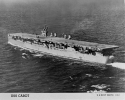 NS022871 |
570k | US Navy photo (probably 1940s) of USS Cabot (CVL-28) underway. |
Tommy Trampp Jim Kurrasch, Battleship Iowa, Pacific Battleship Center |
||||||
 NS022864 |
90k | USS Cabot (CVL-28) in February 1950, from the banks of the Mississippi River near New Orleans, LA. Picture was taken by Lise M. Detruit. |
Walter Protheroe | ||||||
 NS022844 |
96k | A photo of USS Cabot (CVL-28), shown with the AF Guardians of ASW squadron VS-24 on deck, in the early 1950s. USN photo via Floating Drydock. |
David Buell | ||||||
USS Cabot (CVL-28) underway, circa 1951–1952, with what appear to be two AF-2 Guardians from Antisubmarine Squadron (VS) 24 "Duty Cats." |
|||||||||
 NS022884 |
512k | USS Cabot (CVL-28) underway, first half of the 1950s. |
USN | ||||||
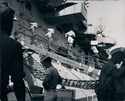 NS022865 |
194k | USS Cabot (CVL-28), loading supplies in preparation for her single Mediterranean cruise, 9 January–26 March 1952. This photo was taken on 30 December 1951, most likely in Pensacola, Florida. |
Ron Reeves | ||||||
 NS022806 |
132k | The Cabot is seen in 1952 as a training and Anti-Submarine warfare carrier. Decommissioned in 1947, the Cabot was recommissioned in this role on October 27, 1948. Note: This image and at least another, similar one, have been several times miscaptioned as "World War 2 images." In fact, they were taken after the ship's FY51 ASW modernization (project SCB-54), as indicated by her port H-4B catapult, modernized island and two, rather than four, funnels. An SNJ trainer is spotted on her flight deck. |
USN | ||||||
 NS022837 |
219k | John F. Floberg, in an SNJ-5C, landing on USS Cabot (CVL-28), April 18, 1952. Official US Navy photograph #441730. Mr. Floberg, Assistant Secretary of the Navy for Air (December 5, 1949–July 23, 1953), qualified as a carrier pilot that day: "On April 18, he made 10 carrier landings and take-offs from the USS Cabot at Pensacola, the last three of them piloting his SNJ without a safety pilot in the rear seat." ("Naval Aviation News," June 1952 issue.) |
Robert M. Cieri | ||||||
 NS022858 |
135k | Alfred Ravo by a twin Bofors 40mm gun mount, aboard USS Cabot (CVL-28), 1952. |
Eddie Ravo, son of Alfred Ravo, USS Cabot |
||||||
 NS022858a |
127k | Alfred Ravo and mates on the flight deck, 1952. |
|||||||
 NS022858b |
86k | Sikorsky HRS-2 Chickasaw, BuNo 129033, modex HT6, from Marine Helicopter Transport Squadron (HMR) 262 "Flying Tigers," 1952. |
|||||||
 NS022858c |
100k | Marines on the flight deck of USS Cabot (CVL-28), 1952. Note a Midway-class carrier on the opposite side of the pier, and a Piasecki HUP-1 Retriever helicopter from Helicopter Utility Squadron (HU) 2 "Fleet Angels" forward of the island. |
|||||||
 NS022881 |
151k | Workmen guide USS Cabot (CVL-28) into drydock at the Philadelphia Navy Yard, 19 April 1953. One workman is using a pointer to communicate directions and the line at the left is actually pulling and spotting the ship in the drydock. Courtesy of the Philadelphia Evening Bulletin, George D. McDowell Philadelphia Evening Bulletin Collection, photo # P556189B. |
Mike Green | ||||||
 NS04020308 |
1.30M | Reserve Fleet Basin, Philadelphia Naval Shipyard, Pennsylvania, photographed on 19 May 1955 with numerous cruisers, escort carriers, and auxiliaries in reserve. The nearest ship is the never-completed Hawaii (CB-3), which lacks her previously-installed three 12" gun turrets. The cruisers outboard of Hawaii are (in unknown order) Honolulu (CL-48), Columbia (CL-56), Denver (CL-58), Galveston (CL-93), and Portsmouth (CL-102). To their left are Tranquility (AH-14), Sanctuary (AH-17), and Pocono (AGC-16). Behind Hawaii (from left to right) are Montpelier (CL-57), Houston (CL-81), Huntington (CL-107), Savannah (CL-42), Cleveland (CL-55), and Wilkes Barre (CL‑103). Beyond them (from left to right) are Wichita (CA-45), Oregon City (CA-122), Chester (CA-27), and New Orleans (CA-32). The cruisers on the left side of the basin (from front to rear) are Minneapolis (CA-36), Tuscaloosa (CA-37), San Francisco (CA-38), Augusta (CA-31), Louisville (CA-28), and Portland (CA-33). Among the other ships in reserve in the basin are Fomalhaut (AE-20), Webster (ARV-2), Albemarle (AV-5), Tangier (AV-8), Pocomoke (AV-9), Chandeleur (AV-10), Abatan (AW-4), Mission San Carlos (AO-120), Prince William (CVE-31), Anzio (CVE-57), Block Island (CVE-106), Palau (CVE-122), and San Carlos (AVP-51). Moored in the shipyard at the extreme left are Tennessee (BB-43), California (BB-44), and Cabot (CVL-28). Official U.S. Navy Photograph, now in the collections of the National Archives (# 80-G-668655). |
Robert Hurst | ||||||
 NS022845 |
310k | A photo of Cabot (CVL-28), taken in Delaware Bay, 24 August 1967, six days before she was commissioned in the Spanish Navy as Dédalo (PH-01). Note that she is still flying US Colors, but has Spanish flight deck markings in process of being applied. USN Photo. |
David Buell | ||||||
| Memorabilia |
|||||||||
 NS022848 |
98k | Ship's patch: "Up An At-Em Mohawks." (See NS022811). |
Robert M. Cieri | ||||||
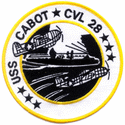 NS022848a |
20k | "USS CABOT CVL 28" |
Courtesy of Popular Patch | ||||||
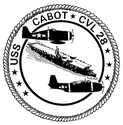 NS022848b |
554k | USS Cabot (CVL-28). |
Wolfgang Hechler | ||||||
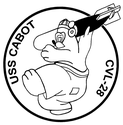 NS022848c |
320k | ||||||||
 NS022847 |
112k | Model and plate on display at the National Naval Aviation Museum, Pensacola, Florida. Photos taken on 13 June 2008. |
Photos by Judson Phillips | ||||||
 NS022847a |
123k | ||||||||
 NS022847b |
132k | ||||||||
 NS022847c |
108k | ||||||||
 NS022847d |
101k | ||||||||
| In Spanish Service |
|||||||||
DÉDALO (PH01)
|
|||||||||
| Name |
|||||||||
 NS022876 |
78k | In Spanish service Cabot was named Dédalo (Daedalus), after the first Spanish seaplane carrier. Built in 1901 as the German merchantman Neuenfels, she was one of six vessels handed over to Spain after World War I as war reparations, and was given the temporary name España nº 6. In 1921 she was transferred to the Spanish Navy, converted into a seaplane carrier and renamed Dédalo. The carrier took part in the Rif War and in September 1925 her seaplanes supported the amphibious landing at Al Hoceima (Alhucemas, the first amphibious landing in history with significant seaborne air support). Dédalo made history again on 7 March 1934, when a rotorcraft (piloted by its inventor, Juan de la Cierva), landed on and took off from a ship, near the port of Valencia, Spain (NS022876, photo signed by de la Cierva himself. The original picture is in the Museo Naval, Madrid). The veteran vessel was decommissioned in January 1935. NS022876b: Watercolor © by Manuel García García, depicting the first Spanish Dédalo. NS022876c: The photograph that inspired the above watercolor. NS022876a: In Greek mythology, Daedalus was a skillful craftsman and artist. He created the Labyrinth for king Minos of Crete, where the Minotaur (a half-man, half-bull creature) was kept. When he was imprisonedin a tower to prevent the secret of his Labyrinth from spreading to the public, he made two sets of wingswith feathers and wax, for himself and his young son Icarus (NS022876a, Daedaulus and Icarus, painting by Charles Le Brun, circa 1645). They jumped off a window and flew toward freedom (unfortunately, Icarus forgot his father's advice, flew too high and the sun melted the wax in his wings, causing him to fall to his death). |
NavSource | ||||||
 NS022876b |
709k | © Manuel García García | |||||||
 NS022876c |
289k | Collection of Jaume Cifré Sánchez, via Manuel García García |
|||||||
 NS022876a |
90k | NavSource | |||||||
 NS022869 |
78k | Ex-USS Cabot (AVT-3) on the day she was transferred to the Spanish Navy as SPS Dédalo (PH-01). Philadelphia Naval Shipyard, 30 August 1967. Courtesy of Temple University Digital Collections, George D. McDowell Philadelphia Evening Bulletin Photographs. |
Temple University, via Michael Mohl | ||||||
 NS022869a |
99k | The Spanish flag is hoisted during the transfer ceremony for USS Cabot as she becomes Dédalo. Philadelphia Naval Shipyard, 30 August 1967. Courtesy of Temple University Digital Collections, George D. McDowell Philadelphia Evening Bulletin Photographs. |
|||||||
 NS022869b |
87k | Returning the salute from two Spanish seamen after the ceremony are 7-year old Peter Durban, of West Hereford, Conn., grandson of RADM Michael, WW II captain of Cabot, and Spanish Lieutenant San Martín. Philadelphia Naval Shipyard, 30 August 1967. Courtesy of Temple University Digital Collections, George D. McDowell Philadelphia Evening Bulletin Photographs. |
|||||||
NS022832 |
63k | Dédalo at anchor, circa 1968. She has three Sikorsky CH-19E Chickasaw (HRS-3 under the pre-1962 designation system) parked on the flight deck; they were assigned to the "Segunda Escuadrilla" (Second Squadron) and affectionately nicknamed Pepos in the Spanish Navy. The small helicopter, aft, appears to be a Bell 47 from "Primera Escuadrilla" (First Squadron). |
Robert Hurst | ||||||
NS022832a |
69k | Another view of Dédalo (PH-01), very similar to the one above and probably taken on the same occasion. |
|||||||
 NS022839 |
57k | The Spanish aircraft carrier Dédalo, ex-USS Cabot, underway, date and location unknown. Note early flight deck markings. |
Robert Hurst | ||||||
 NS022870 |
87k | Helicopter carrier Dédalo (PH01), ex-USS Cabot, underway in 1969, location unknown. Official Spanish Navy photo. |
Robert Hurst | ||||||
 NS022834 |
397k | Location unknown, sometime in 1972-1981. The three small helicopters on the flight deck, forward, are Hughes 500M (the export version of the Hughes 369) assigned to the "Sexta Escuadrilla" (Sixth Squadron) and were received by the Spanish Navy starting in April 1972. The quad 40-mm/56-cal Bofors gun mount on the forecastle was swept overboard by a wave in 1981 or earlier. |
Omar Rubido, former member of the Armada Española | ||||||
NS022835 |
51k | Circa 1974, location unknown. As received by the Spanish Navy, Dédalo had somewhat upgraded electronics, including an SPS-40 air search radar. |
Robert Hurst | ||||||
 NS022833 |
73k | Anchored off Alborán island, Mediterranean Sea, between Spain and Morocco; 1976 (thanks to Manuel Oliva, who provided this information). The Sea King helicopter parked on the flight deck appears to be number "005-4," an SH-3D which was lost in an accident in April 1976. |
Robert Hurst | ||||||
 NS022866 |
941k | SPS Dédalo (PH-01), ex-USS Cabot (CVL-28/AVT-3), with USS Oak Ridge (ARDM-1) in the background. Rota, Spain, 3 July 1976. |
© Richard Leonhardt | ||||||
 NS022866a |
846k | SPS Dédalo (PH-01), ex-USS Cabot (CVL-28/AVT-3). USS Oak Ridge (ARDM-1) in the background, with a submarine aboard and an APL alongside. Rota, Spain, 3 July 1976. |
© Richard Leonhardt | ||||||
 NS022866b |
848k | SPS Dédalo (PH-01), ex-USS Cabot (CVL-28/AVT-3), with USS Raleigh (LPD-1) forward. Rota, Spain, 3 July 1976. |
© Richard Leonhardt | ||||||
 NS022867 |
904k | SPS Dédalo (PH-01), ex-USS Cabot (CVL-28/AVT-3), with USS Elmer Montgomery (FF-1082) and USS Spiegel Grove (LSD-32) in the background. Rota, Spain, 4 July 1976. |
© Richard Leonhardt | ||||||
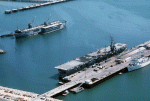 NS09670112 |
409k | The Spanish Navy helicopter carrier Dédalo (PH-01) moored pierside at Naval Station Rota, Spain, 1(?) September 1976. Oak Ridge (ARDM-1) is in the background, and the ship on the right, painted white, may be the survey ship USNS Wyman (T-AGS 34). Department of Defense photo # DN-ST-87-06233. |
Yu Chu | ||||||
 NS022888 |
508k | The Spanish aircraft carrier Dédalo, ex-USS Cabot, underway after 1976, location unknown. Note four Harrier (Matador) V/STOL jets on deck. Spanish Navy photo. |
Robert Hurst | ||||||
 NS022838 |
1.18M | The Spanish aircraft carrier Dédalo, ex-USS Cabot, underway circa 1978, location unknown. Note three Harrier (Matador) V/STOL jets forward and ASW helicopters aft. Spanish Navy photo. |
Robert Hurst Jaume Cifré Sánchez |
||||||
 NS022810 |
79k | Barcelona, Spain, November 28, 1978 — Dédalo (PA-01) had her ECM equipment (WLR-1) mounted on a pole mast located between the stacks. Her island supported another pole mast for radar and other electronic equipment antennas (SPS-10 surface search radar, SPS-6C and SPS-40A air search, URN-22 TACAN, etc.); an SPS-8 height finder was mounted directly atop the island. Also visible are the aircraft crane and gun sponsons with twin 40-mm/56-cal Bofors; note a Mk.51 optical gunfire director on a small sponson below and slightly aft of the aircraft crane. | © Fabio Peña | ||||||
 NS022827 |
91k | Pierside at Rota, Cádiz, Spain, April 1979. A good view of the structures supporting the uptakes and the island. Note that, as in a CVE, the island was built entirely outside the hull and the flight deck. The stacks were angled away from the flight deck in an attempt to reduce corrosion from exhaust gases on parked aircraft. | Photos © by Teodoro Moreno. Submitted by his daughter, Sole. |
||||||
 NS022828 |
102k | ||||||||
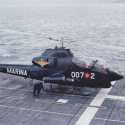 NS022883 |
257k | Spanish Navy AH-1G Huey Cobra of the Séptima Escuadrilla (Squadron Seven) (USAF # 71-15091), on the flight deck of Dédalo. Late 1970s. |
Yu Chu | ||||||
 NS022849 |
151k | A port beam view of the Spanish aircraft carrier Dédalo (R-01), formerly USS Cabot (AVT-3), foreground, and the guided-missile frigate Baleares (F-71), participating in exercise Ocean Venture '81, September 1981, in the Atlantic Ocean. U.S. Navy photo by JO1 Lon Cabot (DVIC id.: DN-ST-82-04670). |
Defense Visual Information Distribution Service | ||||||
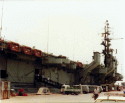 NS022885 |
226k | During the 1980–1981 [19 November 1980–10 June 1981] Med-Indian Ocean cruise aboard USS Independence (CV-62) we stopped at Rota [early June 1981] to take on some stores. Dédalo was pierside taking on sodas. |
Paul Cronin, AKC (AW) USN, Retired | ||||||
 NS022893 |
670k | A view of ships docked at the pier at Naval Station Rota, Spain, dated 1 November 1981. The docked ships include the Spanish small aircraft carrier Dédalo (R01), left. Two tugboats nudge the destroyer USS Jonas Ingram (DD-938) into docking position, and the guided missile cruiser USS Wainwright (CG-28) is off Jonas Ingram's starboard bow. U.S. Navy photo, author unknown. DVIC id: DN-ST-82-01789. |
Yu Chu | ||||||
 NS022878 |
518k | An aerial view of ships anchored, 13 February 1982 (Rota, Spain?). The ships are, from front to back, the Spanish aircraft carrier Dédalo (R-01), the amphibious transport dock USS Raleigh (LPD-1) and the amphibious assault ship USS Saipan (LHA-2). Source: Defense Visual Information Distribution Service, Photo VIRIN : DN-SC-82-08574. |
Yu Chu | ||||||
 NS022830 |
61k | Arsenal de Cartagena, Spain, circa September 1982. Note gangway with "R-01" hull number: Dédalo received a new, "R"-series number, in accordance with European NATO navies practice for aircraft carriers, in 1980 — many months before Spain's official entry into the Organization, in May 1982. |
© Gonzalo Aira | ||||||
 NS022831 |
80k | Then Seaman Aira with one of the Sea Kings assigned to "Quinta Escuadrilla" (Fifth Squadron) on the flight deck of Dédalo, Arsenal de Cartagena, Spain, circa September 1982. The Spanish Navy received 18 SH-3's between 1966 and 1981, of which 14 remained in service at the time this photo was taken — four having been lost in accidents. |
© Gonzalo Aira | ||||||
 NS022816 |
100k | Barcelona, Spain, January 22, 1983 — Dédalo (R-01) with four AV-8A Harrier (Matador, in the Spanish Navy) parked forward. Dédalo was the first carrier in the world to operate these VSTOL aircraft in a strike role. Note the flight-deck extension to port, needed to wheel aircraft around the forward elevator well. |
© Fabio Peña | ||||||
 NS022861 |
126k | Dédalo (R-01) at Barcelona, Spain, 21 January 1984, flying the flag of VADM Enrique Contreras, General Commander of the Fleet. Parked on deck are four AV-8A Matador (Harrier) VSTOL aircraft, and four SH-3D Sea King and four Agusta-Bell AB-212 helicopters. The aircraft carrier was to receive her second Battle Ensign on 22 January. Her first (Spanish) Battle Ensign had also been presented by the city of Barcelona, on 12 October 1968. The change was needed to match the new, constitutional Spanish flag. |
© Fabio Peña | ||||||
 NS022861a |
156k | ||||||||
 NS022846 |
161k | A photograph of the SNS Dédalo, formerly USS Cabot (CVL-28) taken in April 1984 in Rota, Spain. |
Photo by William F. Fessenden | ||||||
 NS022852 |
38k | Aboard Dédalo (R-01), somewhere in the Mediterranean Sea, off the Spanish coast, circa 1984. |
José Hidalgo Aponte | ||||||
 NS022852a |
38k | ||||||||
 NS022853b |
139k | Twin Bofors 40mm gun mount. Rota, Spain. Date unknown. |
Jaume Matamala | ||||||
 NS022853 |
46k | Aboard Dédalo (R-01), Rota, Spain, circa 1984. |
José Hidalgo Aponte | ||||||
 NS022853a |
33k | ||||||||
 NS022804 |
53k | A photo of Cabot in Spanish service (R-01 Dédalo). Photo was taken May 1985 at Muelle del Centenario (Centennial Pier),* La Coruña, Spain during Dia de las Fuerzas Armadas. * (Thanks to Francisco Javier Santos Vazquez.) |
© Ignacio López | ||||||
 NS022836 |
153k | In port, Vigo, Spain, June 1987. |
Manolo Budiño Carlés | ||||||
 NS022805 |
105k | Attached is a picture I took of SNS Dédalo taken June of 1987 in Rota, Spain. | © Thomas S. LaLumiere
Former Sergeant, USMC |
||||||
 NS022862 |
191k | An aerial port bow view of the Spanish aircraft carrier Dédalo (R01) underway in the Mediterranean Sea, 1 June 1988. Note the four AV-8S Matadors aft, plus a Sikorsky SH-3D Sea King and two Agusta-Bell 212s on the flight deck. USN photo by LCDR John Leenhouts (# DN-SC-88-08303). |
Jaume Matamala Robert Hurst |
||||||
 NS022862a |
136k | An air-to-air front view of a Spanish AV-8S Matador aircraft in flight over the Spanish aircraft carrier Dédalo (R01), below, in the Mediterranean Sea, 1 June 1988. USN photo by LCDR John Leenhouts (# DN-SC-88-08301). |
Robert Hurst | ||||||
 NS022862b |
452k | An aerial port view of the Spanish aircraft carrier Dédalo (R01) underway in the Mediterranean Sea, 1 June 1988 (see above). USN photo by LCDR John Leenhouts (# DN-SC-88-08302). |
Bob Canchola, BT, USN (Ret.) | ||||||
 NS022890 |
338k | Island of the Spanish aircraft carrier Dédalo (R01), Rota, Spain, circa late 1988. Compared to photo NS022866, note absence of SPS-8A radar antena, and two stays supporting the mast, after a helicopter accident in 1986. |
Photo by Antonio Gómez Martín | ||||||
 NS022809 |
64k | The Dédalo (ex USS Cabot) in Palma de Mallorca (Spain) in June 1989. Four AV-8A Harriers can be identified on the flight deck. | © José M. Rico
Webmaster of The Battleship Bismarck website |
||||||
 NS022863 |
108k | Commemorative Medal. |
Manuel García García | ||||||
 NS022856 |
143k | Dédalo arrives in New Orleans, LA, 2 August 1989. NS022856: About to pass under the Huey P. Long Bridge. NS022856a: A harbor tug shoots her fire hoses in salute. Photo by Alexander Barkoff. NS022856b: The same photo, as shown on The Times-Picayune, Thursday, 3 August 1989. NS022856c: Moored, close to Bourbon Street. NS022856d: Decommissioned and stricken from the Spanish Navy, and handed over to the Cabot/Dédalo Association, 5 August 1989. NS022856e–NS022856h: More photos taken on the same occasion. Note, in photo NS022856g, two men are in the uniform of the Granaderos de Galvez. These pictures were probably taken by Mr. Howard H. Skidmore, CAPT, USN (Ret.). NS022856i: Ex-Cabot, ex-Dédalo, as seen from the Huey P. Long Bridge, 7 August 1989. |
Manuel García García | ||||||
 NS022856a |
611k | ||||||||
 NS022856b |
335k | ||||||||
 NS022856c |
165k | ||||||||
 NS022856d |
151k | ||||||||
 NS022856e |
131k | Manuel García García | |||||||
 NS022856f |
113k | ||||||||
 NS022856g |
113k | ||||||||
 NS022856h |
145k | ||||||||
 NS022856i |
114k | ||||||||
| The Scrapping |
|||||||||
Photos of ex-USS Cabot/SPS Dédalo taken in New Orleans by Robert Webber, 1990 (or possibly earlier).
|
|||||||||
 NS022854 |
160k | A series of photos of ex-USS Cabot (CVL-28/AVT-3), ex-SPS Dédalo (PH-01/PA-01/R-01). New Orleans, Louisiana, May 1990. |
John Skillman. | ||||||
 NS022854a |
103k | ||||||||
 NS022854b |
117k | ||||||||
 NS022854c |
136k | ||||||||
 NS022854d |
137k | ||||||||
 NS022854e |
152k | ||||||||
 NS022854f |
99k | A series of photos of ex-USS Cabot (CVL-28/AVT-3), ex-SPS Dédalo (PH-01/PA-01/R-01). New Orleans, Louisiana, May 1990. |
John Skillman. | ||||||
 NS022854g |
113k | ||||||||
 NS022854h |
145k | ||||||||
 NS022854i |
143k | ||||||||
 NS022854j |
117k | ||||||||
 NS022854k |
133k | ||||||||
 NS022829 |
132k | New Orleans, 1994. |
Photo by Bruce Leininger. | ||||||
 NS022894 |
132k | New Orleans, 29 September 1995. The red steeple of St. Vincent de Paul (now known as Blessed Francis X. Seelos) Church, Bywater, is visble in the distance. |
Via Gerhard Mueller-Debus. | ||||||
 NS022802 |
52k | New Orleans — Seen here docked in New Orleans LA, At the time she was waiting to be preserved as a memorial after her return from Spain. That effort failed and she was towed to Brownsville TX. in January 1998 to be broken up. A Judge for the Federal district of south Texas halted the scrapping and the matter is still pending. (NOTE) Cabot is the only remaining member of her class, and essentially unaltered from her W.W.II appearance. (see Fate). |
© Bill Bollinger | ||||||
 NS022803 |
53k | New Orleans — See above. | © Bill Bollinger | ||||||
 NS022822 |
64k | New Orleans — Photo by Chuck Self. | Steve Whitby | ||||||
 NS022823 |
92k | New Orleans — Photo by Chuck Self. | Steve Whitby | ||||||
 NS022824 |
129k | New Orleans — Photo by Chuck Self. | Steve Whitby | ||||||
 NS022825 |
135k | New Orleans — Photo by Chuck Self. | Steve Whitby | ||||||
 NS022817 |
45k | Brownsville — View of the Navigation Station. Photo by Stephen O'Neal. | © USS Cabot Museum / ECOSAT | ||||||
 NS022818 |
32k | Brownsville — View of the hangar deck, looking aft. Photo by Stephen O'Neal. | © USS Cabot Museum / ECOSAT | ||||||
 NS022819 |
48k | Brownsville — October 2000. | © USS Cabot Museum / ECOSAT | ||||||
 NS022880 |
79k | Brownsville, Texas, at around the same time as the photo above. | Yu Chu | ||||||
 NS022820 |
71k | Brownsville—21 March 2001. In a last minute effort to preserve something of the ship, the Texas Air Museum (Rio Hondo, Tx) acquired the island, CIC, and pilot briefing room for a museum exhibit which would have served as the USS Cabot Memorial. NS022820a: The island, however, was finally demolished. (See video here.) |
© USS Cabot Museum / ECOSAT | ||||||
 NS022820a |
28k | Yu Chu | |||||||
 NS022821 |
62k | Brownsville — June 2002. | © USS Cabot Museum / ECOSAT | ||||||
|
|||||||||
| Crew Contact and Reunion Information | ||||||||||||||||
|
| Related Links |
|
Hazegray & Underway World Aircraft Carrier Pages By Andrew Toppan. USS Cabot CVL-28 Association A History of the USS Cabot (CVL-28): A Fast Carrier in World War II, by J. Ed Hudson |
| Main Photo Index |
Aircraft Carrier Photo Index Page |
Auxiliary Aircraft Landing Training Ship (AVT) Index Page |
Cruiser Photo Index Page |
Comments, Suggestions or Image submissions, E-mail Carrier Information
Problems and site related matters, E-mail Webmaster
This page was created by Paul Yarnall and is maintained by Fabio Peña
![]()
Last update: 20 May 2024